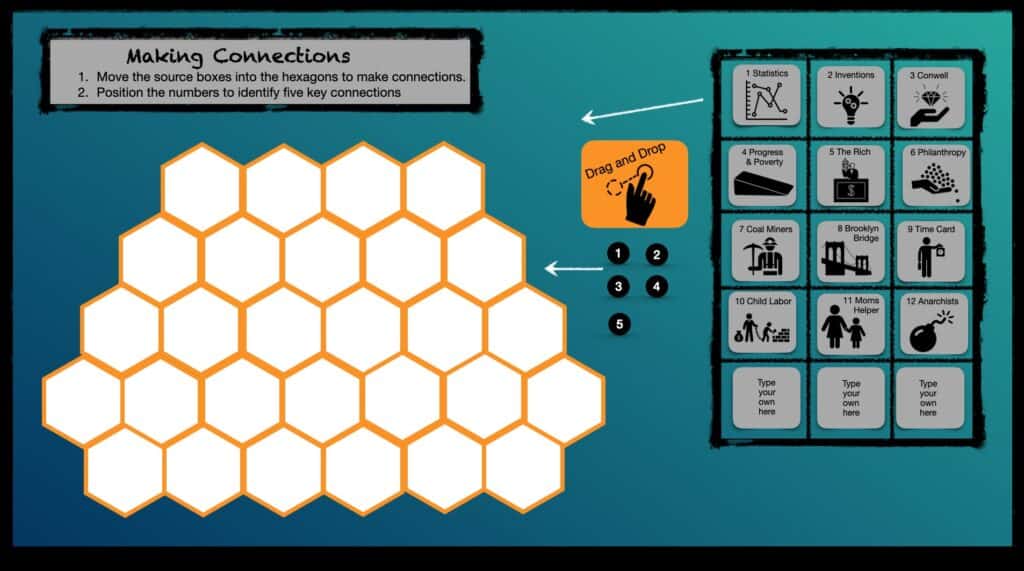Featured image: Lewis Hine Library of Congress
Overview
We will continue our examination of historical thinking skills based on the work by Stanford History Education Group. (SHEG). This curriculum teaches students how to investigate historical questions by employing reading strategies such as sourcing, contextualizing, corroborating, and close reading. This session will use a selection of documents from the late 19th century to explore corroborating in the context of the rise of industrial America.
Class Session
Students will work in teams to explore the documents in Progress and Poverty in Industrial America (available free at iTunes). Also available online as a Microsoft Sway. Both adapted from PDF version Work, Culture and Society in Industrial America.
We will be using the 11 sources to create a graphic organizer that responds to the essential question: “How do we evaluate the social costs and benefits of technological innovations?”
Students will be supplied with the “Hexagonal Thinking Corroboration Tool” in Keynote. Corroboration prompts are from SHEG. This thinking tool inspired by this post. Keynote design adapted from here.

After our review of the 19th century documents, we will consider the same essential question in the context of contemporary America.
Assignment 6: NO PUBLISHED POST THIS WEEK
There is no published post for this week. Instead, student will prepare a lesson idea pitch to deliver in next week’s class. The pitch should be planned to take 5 – 8 minutes. After the pitch, the class and instructor will give feedback.
NOTE: You don’t need to share the resources you will use or do any “teaching” during your pitch. You are tossing out an idea for us to give you feedback. Students may want to try out a few ideas to see which one “works” the best.
Topics to cover in your pitch
- Lesson Background: Subject, audience, context as part of larger lesson (ie. intro, check for understanding, etc)
- Instuctional goal: What will students know or be able to do at conclusion?
- Resources: What resources are needed?
- Process: What will the teacher do? Students do?
- Logistics / timing: Have you thought through the delivery? Any special considerations – reading required, working via Zoom, other apps, etc?
Example of my “Pitch” I would have done to describe today’s class.
- Lesson Background: We have been studying historical thinking skills. Today’s lesson will illustrate corroboration.
- Instuctional goal: I want to get the students working in teams to corroborate a variety of primary and secondary sources from the Industrial Era of late 19th century. Illustrate the power of an essential question by revisiting the theme in the current world. Show students how they might curate a collection of sources to support a lesson. See if a tech tool can support learning.
- Resources: Re-use some content I had previously created – eBook and Sway presentation. Create a virtual way to interact with symbols to illustrate corroboration.
- Process: Teacher introduces the task and tools. Manages the time and reporting of each task. Manage breakout groups and task timing. Support discussion of results.
Students will: 1. Identify details in individual sources. 2. Work in teams using the Keynote tool to make connections between sources. 3. Breakout groups share connections. 4 Use shared Jamboard to create a modern equivalent answering the same essential question. - Logistics / timing: Make sure each group has at least one member with Keynote or PowerPoint apps available. Share templates. Should be achievable in about an hour. Note: I’m not held to shorter lesson timing.
Looking Ahead -Teach a Lesson After Fall Break
Students will develop and deliver a 20-25 min lesson in their assigned class. Student should be prepared to deliver the lesson via Zoom in our Oct 18th class.
About the lesson The lesson should teach historical thinking skill(s). Specific content of lesson is up to you.
- This lesson should be delivered as if we were your class.
- Your peers will serve as participant observers noting lesson content, nature of the student task, lesson delivery and student workflow.
- Feel free to design a flipped lesson in advance and let the class know of your plans and required viewing.
- If you have a significant amount of reading required, send it to us in advance.

![Fourteen year old spinner in a[?] Brazos Valley Cotton Mill at West. Violation of the law. Matty Lott runs six sides.](https://edmethods.com/wp-content/uploads/2020/09/Fourteen-year-old-spinner-in-Brazos-Valley-Cotton-Mill.jpg)